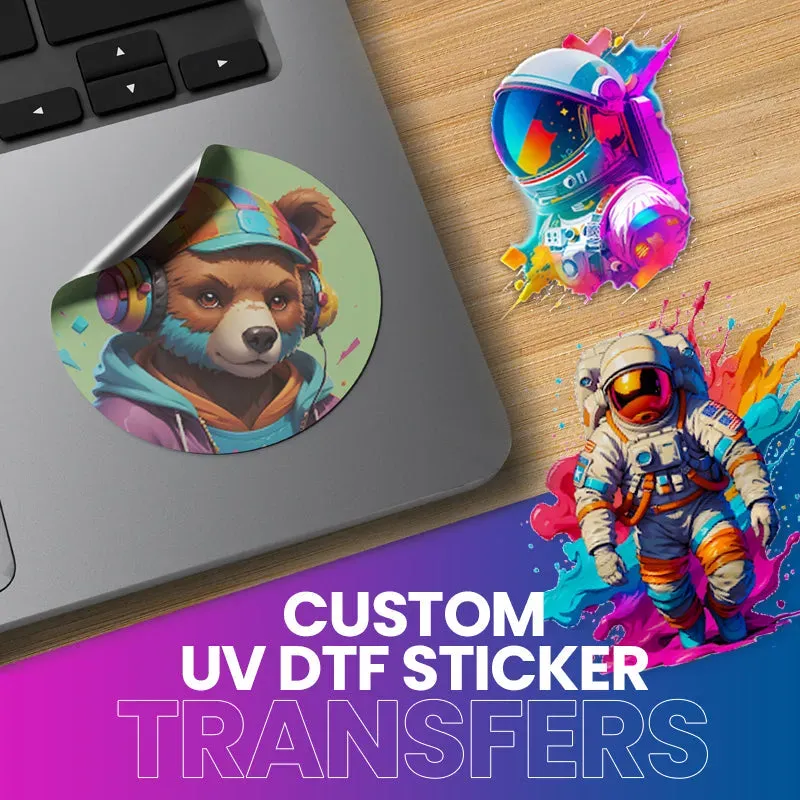The durability of UV DTF transfers is a paramount concern for businesses and consumers alike as they navigate the vibrant world of UV Direct-to-Film printing. This innovative method allows for the creation of stunning, colorful designs on a range of substrates, from fabrics to promotional products. However, understanding how durable these prints can be is key to ensuring they last through the rigors of wear and washing. In this article, we will explore the durability of UV DTF transfers, focusing on their resistance to fading and abrasion, to help you make informed decisions for your custom prints. By delving into the factors affecting transfer durability, we aim to provide insights that enhance your experience with this cutting-edge technology, whether for retail or personal use.
When discussing the resilience of UV DTF prints, alternative terms such as transfer permanence and print longevity come to mind. Utilizing ultraviolet Direct-to-Film techniques, these transfers offer a modern solution for achieving exceptional graphics on diverse materials. This printing method is gaining traction due to its ability to deliver impressive visuals while also addressing concerns related to fabric durability under various conditions. As we further investigate the key elements influencing the performance and lifespan of these prints, we will consider how their effectiveness stacks up against traditional screen printing techniques. Gaining a deeper understanding of these comparisons will enable businesses and consumers to select the best options for their printing needs.
The Magic of UV DTF Printing Technology
UV Direct-to-Film (DTF) printing technology offers a revolutionary approach to producing high-quality prints. By employing ultraviolet light, this method cures the ink, transforming it into a durable layer on various substrates. The magic lies in its ability to deliver rich, vibrant colors that can stand out on dark backgrounds or textured surfaces, making it perfect for custom prints. This enhanced capability positions UV DTF transfers as a significant competitor in the printing market, especially for those seeking unique and visually appealing designs.
In contrast to traditional screen printing, where color mixing can complicate designs, UV DTF allows for intricate and detailed visuals without the same limitations. Users can achieve several color variations and gradients seamlessly, creating designs that maintain their integrity across various applications. From promotional items to personalized apparel, the versatility of UV DTF opens avenues for businesses aiming to enhance their product offerings with eye-catching graphics.
Durability of UV DTF Transfers: What to Expect
When considering the durability of UV DTF transfers, expectations can vary. Generally, UV DTF prints are engineered to last, showing resilience against fading and abrasion over time. With the right materials and application processes, the transfer’s longevity can be quite impressive, though results may fluctuate based on the substrate and environmental stress. Businesses often prefer UV DTF for its ability to produce long-lasting custom prints without compromising on quality.
However, it is essential to compare these transfers against traditional methods, such as screen printing, which is widely regarded for its superior durability in high-wear applications. While UV DTF prints are resilient, they might not always withstand the rigors of industrial environments where resistance to abrasion and washing is critical. Understanding these differences can help businesses make informed decisions depending on their specific product requirements.
Essential Factors Affecting Transfer Durability
The durability of UV DTF transfers hinges on several key factors, each playing a significant role in determining how the final product will perform. Among these, the quality of materials—including the UV inks and base film—is paramount. High-grade inks apply better adhesion properties and resist fading longer, critical for maintaining visual appeal over time, especially after multiple wash cycles.
Moreover, the adhesive quality used in the application process significantly impacts longevity. A robust adhesive ensures strong bonding between the print and fabric, enhancing resistance to wear and weather conditions. Thus, selecting appropriate materials and adhering to manufacturer specifications can make a substantial difference in how UV DTF prints hold up throughout their lifecycle.
Washing Guidelines for Optimal Performance
To ensure the durability of UV DTF transfers, adhering to proper washing guidelines is crucial. Typically, washing items in cold water minimizes the risk of degrading the print’s integrity and vibrancy. Additionally, avoiding harsh detergents or bleach can significantly extend the life of the prints, preserving their colors and preventing cracks.
It’s also advisable to turn printed garments inside out before washing, as this reduces friction against the fabric, further safeguarding the print. By implementing these simple care tips, users can enjoy longer-lasting UV DTF prints, effectively maintaining their quality over repeated washes.
Advantages of UV DTF Over Traditional Printing Methods
UV DTF printing technology presents a unique edge over traditional methods like plastisol screen printing, particularly in terms of customization and versatility. While screen printing can be limiting due to its setup process, UV DTF’s ease of use makes it an appealing choice for small runs or custom projects. This flexibility allows businesses to cater to a wider audience, from personalized apparel to bespoke promotional products.
Moreover, UV DTF conveys the advantage of printing on diverse substrates, including textiles, plastics, and metals. This level of adaptability means that businesses can expand their service offerings and attract various customer markets. Innovations in UV ink formulations further enhance this adaptability, ensuring that prints can withstand various environmental conditions without compromising print quality.
Future Trends in UV DTF Printing Technology
The future of UV DTF printing is bright, as ongoing advancements in technology promise to push the boundaries of print durability and quality. Recent developments focus on creating more resilient ink formulations that offer heightened lightfastness and flexibility. These innovations not only enhance the visual appeal of prints but also improve their performance when subjected to washing or stretching, ensuring that customers receive products that stand the test of time.
As the industry evolves, we can expect further enhancements in UV DTF technology, driving improvements in environmental resistance and adhesion. These advancements will likely keep UV DTF transfers competitive with traditional printing methods, particularly in niche markets where quality and durability are paramount. Staying informed about these trends will be vital for businesses looking to harness the latest in printing technology.
Frequently Asked Questions
What is the expected durability of UV DTF transfers compared to traditional screen printing?
UV DTF transfers typically offer good durability; however, traditional screen printing may outperform them in environments with heavy wear. While UV DTF can withstand numerous wash cycles, screen prints are generally stronger under harsh conditions, making them more suitable for industrial applications.
How can I extend the durability of my UV DTF prints on fabric?
To enhance the durability of UV DTF prints, follow care instructions by washing in cold water with mild detergents. Avoid bleach and harsh chemicals that can damage the print. Proper storage away from sunlight also helps maintain print vibrancy.
What factors affect the transfer durability of UV DTF printing?
The durability of UV DTF transfers is influenced by material quality, adhesive strength, and the washing practices used. High-quality inks and adhesives ensure better resistance to fading and wear, while proper washing and care maintain the prints’ lifespan.
Are UV DTF transfers suitable for all fabric types regarding durability?
While UV DTF transfers can be applied to various textiles, not all fabrics provide the same level of durability. Smooth fabrics typically yield better adhesion than textured or heavily woven materials, which can compromise the longevity of the prints.
How does UV ink quality impact the durability of UV DTF transfers?
The quality of UV inks is critical for transfer durability. Superior UV inks are resistant to fading, scratching, and abrasion, which enhances the longevity of the prints. Using high-quality inks ensures that the vibrant designs maintain their appearance over time.
What are the best practices to ensure the durability of custom prints using UV DTF technology?
To ensure the durability of custom prints with UV DTF technology, always follow the manufacturer’s washing and care instructions, avoid harsh chemicals, and store the items in a cool, dry place. Implementing these practices will help maintain the vibrancy and integrity of your prints.
| Key Factor | Description | Impact on Durability |
|---|---|---|
| Material Quality | The quality of the base film and UV inks used. | Superior resistance to fading, scratching, and abrasion. |
| Adhesive Strength | The type and quality of the adhesive used in the printing process. | Enhances bonding with the substrate, increasing color retention after washing. |
| Washing and Wear | Durability under washing and everyday use. | May not hold up as well as traditional prints under heavy use. |
| Recent Advances | Innovations in ink formulations enhance performance. | Improved lightfastness and environmental resistance. |
| Best Practices | Guidelines for care and maintenance of prints. | Helps maintain vibrancy and prolongs the life of prints. |
Summary
The durability of UV DTF transfers is a crucial consideration for both consumers and businesses navigating the printing landscape. Understanding the interplay of factors such as material quality, adhesive strength, and washing practices is essential for ensuring lasting vibrancy in printed items. With recent advances in technology further bolstering the resilience of UV DTF transfers, adhering to best practices can enhance their lifespan and visual appeal. Exploring these insights will empower you to make informed decisions when utilizing UV DTF transfers, whether for commercial printing needs or DIY projects.



